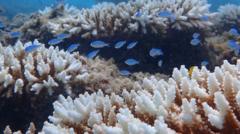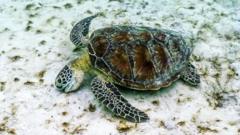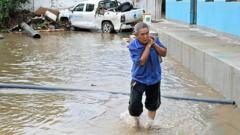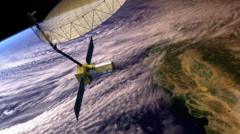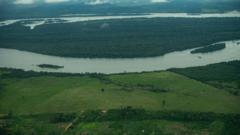"Researchers have discovered the largest coral in the Pacific, measuring 34 meters wide and over 300 years old, raising awareness about the ecological importance of corals and the threat they face from climate change."
"Discovery of Earth’s Largest Coral Offers Glimpse into Resilience Against Climate Change"

"Discovery of Earth’s Largest Coral Offers Glimpse into Resilience Against Climate Change"
"A remarkable find in the Pacific highlights the urgent need for coral conservation amid climate challenges faced globally."
In a groundbreaking discovery, scientists have identified the world's largest coral in the southwest Pacific Ocean, marking a significant milestone in coral research and climate change awareness. This extraordinary coral, a massive collection of connected polyps that function as a single organism, is estimated to be over 300 years old and exceeds the size of a blue whale. The coral measures an impressive 34 meters wide, 32 meters long, and 5.5 meters high, showcasing the resilience of marine ecosystems even in the face of climate change.
The find occurred while videographer Manu San Felix was aboard a National Geographic ship exploring remote regions of the Pacific, aiming to assess the impacts of climate change on marine life. During a dive near the Solomon Islands, he initially sought a shipwreck but instead stumbled upon what he described as a "cathedral underwater." The emotional experience underscored the coral's historical significance, linking it to centuries past, even before the time of Napoleon.
Scientists employed an underwater tape measure to gather precise dimensions of the coral, which is located in deeper waters, potentially shielding it from the elevated temperatures that affect surface coral reefs. In light of this discovery, the UN climate talks COP29 commenced in Baku, Azerbaijan, highlighting critical discussions regarding climate action and coral protection.
Speaking at the summit, Solomon Islands Climate Minister Trevor Manemahaga emphasized the unique attributes of this newly discovered coral. He remarked on the essential role corals play in the nation’s economy, which heavily relies on marine resources. He reiterated the urgency of protecting such critical ecosystems from exploitation, given the increasing threats posed by climate change to small island nations like his.
Manemahaga’s concerns echo the current realities faced by many developing countries as they seek financial assistance from wealthier nations to navigate climate challenges. He noted the ongoing struggles with powerful cyclones and coastal erosion, which threaten the livelihood and homes of local communities.
Eric Brown, one of the coral scientists involved in the research expedition, expressed optimism about the coral’s health. Brown highlighted that, unlike the degraded shallow reefs nearby, this large coral oasis presents a beacon of hope amid concerning trends. This specific coral species, Pavona clavus, not only supports diverse marine life, including shrimp, crabs, and fish, but also serves as a historical record of past oceanic conditions.
As reported by the International Union for the Conservation of Nature, there is a pressing threat facing coral species globally, with around 44% of warm-water corals now at risk of extinction, an alarming increase since the last assessment in 2008. This new discovery underscores the need for significant conservation efforts to protect these vital ecosystems against the backdrop of an uncertain future influenced by climate change.


